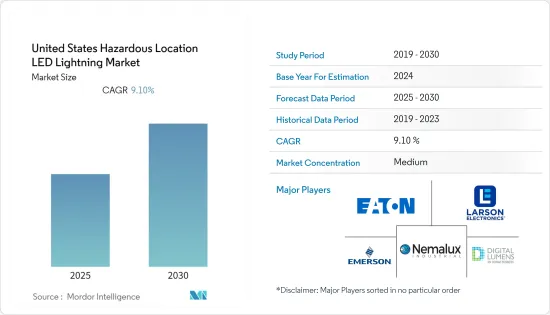Need help finding what you are looking for?
Contact Us
PUBLISHER: Mordor Intelligence | PRODUCT CODE: 1631606

PUBLISHER: Mordor Intelligence | PRODUCT CODE: 1631606
United States Hazardous Location LED Lightning - Market Share Analysis, Industry Trends & Statistics, Growth Forecasts (2025 - 2030)
PUBLISHED:
PAGES: 120 Pages
DELIVERY TIME: 2-3 business days
SELECT AN OPTION
The United States Hazardous Location LED Lightning Market is expected to register a CAGR of 9.1% during the forecast period.

Key Highlights
- The capital investment in retrofitting a hazardous location facility to LED technology can be significant. However, when the change to LED is implemented effectively, it offers a compelling return on investment(ROI) in energy savings, reduced long-term maintenance, and improved facility safety.
- The manufacturing industry accounts for nearly 32% of the energy usage in the United States while representing the most significant energy cost reduction opportunities in the country. Therefore, the LED lighting systems provide a potential chance to cost-effectively eliminate 15% to 32% of the energy usage by 2025.
- The vendors in the region are observed to have increasingly participated in multiple launches to upgrade their existing LED lighting offerings for hazardous locations. For instance, in the recent past, Emerson introduced a solution for the oil and gas industry to illuminate land-based drilling rigs.
- To attract industrial customers, customizing light output by the environment has become a common trend among manufacturers. Hence, tunable LED lighting solutions have been witnessing an improvement in adoption in the past few years. In the market studied, mergers, acquisitions, and collaborations are the prevailing trends adopted among the market players for product innovation and inorganic growth.
- The outbreak of COVID-19 has led to a weakened growth of industrial output and the decline in light-manufacturing production across significant manufacturing hubs, owing to the halting of production and disruption in the supply chain across the country. According to the US Department of Energy's report published in July 2021, many LED manufacturers cited a decreased demand for lighting products due to the challenges faced after the COVID-19 pandemic.
US Hazardous Location LED Lighting Market Trends
Increasing Demand for Low-Cost, Low-Energy LED Lighting Solutions
- The market studied is driven by many factors, such as improved manufacturing efficiency, lower prices, improved LED efficacy in recent years, and suitable LED lamps and retrofit kits, which can directly replace the existing halogen incandescent and fluorescent lamps.
- LED is a highly energy-efficient technology for lighting. According to the US Department of Energy, residential LEDs in the United States, especially ENERGY STAR-rated products, use at least 75% less energy and have a life span that is 25 times longer than incandescent lighting. Also, LEDs are small and directional, suitable for various uses in residential settings. Owing to these benefits, indoor application and residential uses are the largest revenue-generating segments in the studied market.
Industrial Application is Going to Observe a Significant Growth
US Hazardous Location LED Lighting Industry Overview
Additional Benefits:
Product Code: 72256
TABLE OF CONTENTS
1 INTRODUCTION
- 1.1 Study Assumptions and Market Definition
- 1.2 Scope of the Study
2 RESEARCH METHODOLOGY
3 EXECUTIVE SUMMARY
4 MARKET INSIGHTS
- 4.1 Market Overview
- 4.2 Industry Attractiveness - Porters Five Force Analysis
- 4.2.1 Bargaining Power of Suppliers
- 4.2.2 Bargaining Power of Consumers
5 TECHNOLOGY SNAPSHOT
6 MARKET DYNAMICS
7 MARKET SEGMENTATION
8 COMPETITIVE LANDSCAPE
9 INVESTMENT ANALYSIS
10 FUTURE OUTLOOK OF THE MARKET
Have a question?


SELECT AN OPTION
Have a question?


Questions? Please give us a call or visit the contact form.
